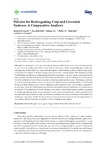Use este identificador para citar ou linkar para este item:
http://www.alice.cnptia.embrapa.br/alice/handle/doc/1067451Registro completo de metadados
| Campo DC | Valor | Idioma |
|---|---|---|
| dc.contributor.author | GARRETT, R. D. | pt_BR |
| dc.contributor.author | NILES, M. | pt_BR |
| dc.contributor.author | GIL, J. | pt_BR |
| dc.contributor.author | DY, P. | pt_BR |
| dc.contributor.author | REIS, J. C. dos | pt_BR |
| dc.contributor.author | VALENTIM, J. F. | pt_BR |
| dc.date.accessioned | 2017-03-22T11:11:11Z | pt_BR |
| dc.date.available | 2017-03-22T11:11:11Z | pt_BR |
| dc.date.created | 2017-03-22 | pt_BR |
| dc.date.issued | 2017 | pt_BR |
| dc.identifier.citation | Sustainability, Switzerland, v. 9, n. 3, p. 473-494, Mar. 2017. | pt_BR |
| dc.identifier.issn | 2071-1050 | pt_BR |
| dc.identifier.uri | http://www.alice.cnptia.embrapa.br/alice/handle/doc/1067451 | pt_BR |
| dc.description | The reintegration of crop and livestock systems within the same land area has the potential to improve soil quality and reduce water and air pollution, while maintaining high yields and reducing risk. In this study, we characterize the degree to which federal policies in three major global food production regions that span a range of socioeconomic contexts, Brazil, New Zealand, and the United States, incentivize or disincentivize the use of integrated crop and livestock practices (ICLS). Our analysis indicates that Brazil and New Zealand have the most favorable policy environment for ICLS, while the United States provides the least favorable environment. The balance of policy incentives and disincentives across our three cases studies mirrors current patterns of ICLS usage. Brazil and New Zealand have both undergone a trend toward mixed crop livestock systems in recent years, while the United States has transitioned rapidly toward continuous crop and livestock production. If transitions to ICLS are desired, particularly in the United States, it will be necessary to change agricultural, trade, environmental, biofuels, and food safety policies that currently buffer farmers from risk, provide too few incentives for pollution reduction, and restrict the presence of animals in crop areas. It will also be necessary to invest more in research and development in all countries to identify the most profitable ICLS technologies in each region. | pt_BR |
| dc.language.iso | eng | eng |
| dc.rights | openAccess | eng |
| dc.subject | Agroecologia | pt_BR |
| dc.subject | Integração lavoura-pecuária (iLP) | pt_BR |
| dc.subject | Integrated Crop and Livestock Systems (ICLS) | pt_BR |
| dc.subject | Estados Unidos | pt_BR |
| dc.subject | Nova Zelândia | pt_BR |
| dc.subject | Brasil | pt_BR |
| dc.subject | Agricultura sustentable | pt_BR |
| dc.subject | Política pública | pt_BR |
| dc.title | Policies for reintegrating crop and livestock systems: a comparative analysis. | pt_BR |
| dc.type | Artigo de periódico | pt_BR |
| dc.date.updated | 2017-03-28T11:11:11Z | pt_BR |
| dc.subject.thesagro | Agricultura sustentável | pt_BR |
| dc.subject.thesagro | Ecologia vegetal | pt_BR |
| dc.subject.thesagro | Políticas públicas | pt_BR |
| dc.subject.nalthesaurus | Sustainable agriculture | pt_BR |
| dc.subject.nalthesaurus | Agroecology | pt_BR |
| dc.subject.nalthesaurus | Public policy | pt_BR |
| dc.subject.nalthesaurus | Brazil | pt_BR |
| dc.subject.nalthesaurus | United States | pt_BR |
| dc.subject.nalthesaurus | New Zealand | pt_BR |
| riaa.ainfo.id | 1067451 | pt_BR |
| riaa.ainfo.lastupdate | 2017-03-28 | pt_BR |
| dc.identifier.doi | 10.3390/su9030473 | pt_BR |
| dc.contributor.institution | Rachael D. Garrett, Boston University; Meredith Niles, University of Vermont; Juliana Gil, Boston University / Wageningen University; Philip Dy, Harvard University; JULIO CESAR DOS REIS, CPAMT; JUDSON FERREIRA VALENTIM, CPAF-Acre. | pt_BR |
| Aparece nas coleções: | Artigo em periódico indexado (CPAF-AC)  | |
Arquivos associados a este item:
| Arquivo | Descrição | Tamanho | Formato | |
|---|---|---|---|---|
| 26289.pdf | 617,65 kB | Adobe PDF |  Visualizar/Abrir |









